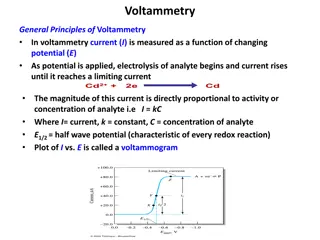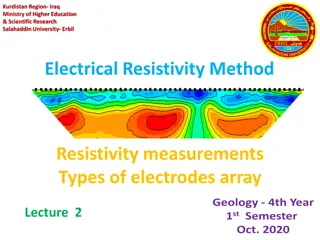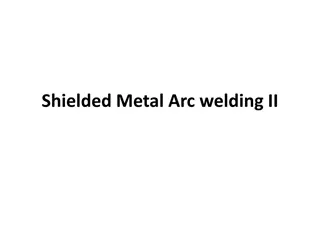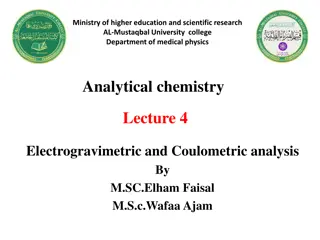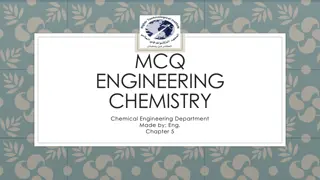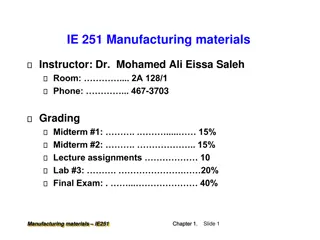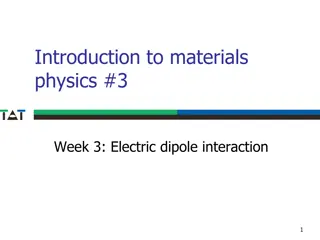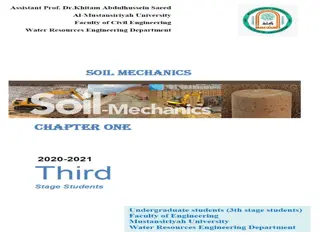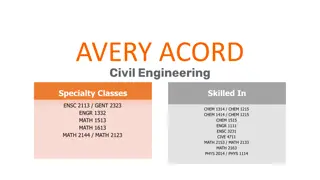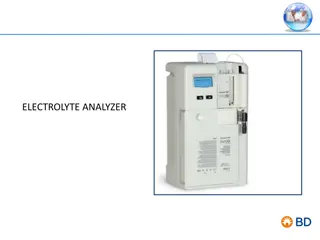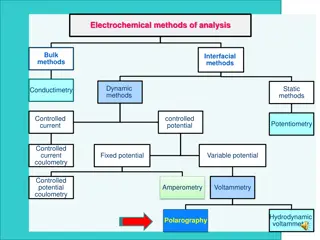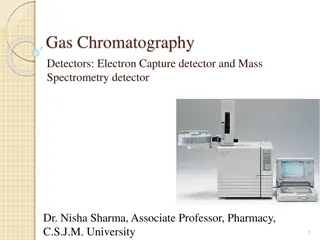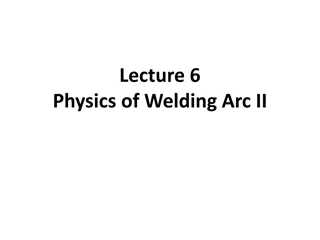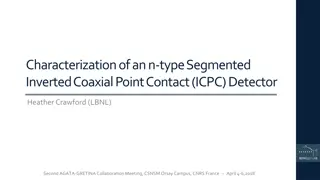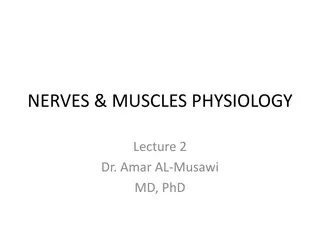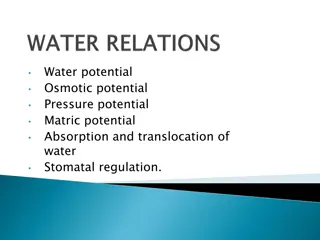Understanding Electrode Potential in Materials Engineering
In materials engineering, understanding electrode potential is crucial. The hydrogen electrode serves as a reference for potential measurements in aqueous solutions, but has limitations in oxidizing media. On the other hand, the silver-silver chloride electrode provides a dynamic equilibrium between silver and chloride ions. Knowing the equations and reactions involved helps in determining electrode potential accurately.
- Materials Engineering
- Electrode Potential
- Hydrogen Electrode
- Silver-Silver Chloride Electrode
- Equilibrium Reactions
Download Presentation

Please find below an Image/Link to download the presentation.
The content on the website is provided AS IS for your information and personal use only. It may not be sold, licensed, or shared on other websites without obtaining consent from the author. Download presentation by click this link. If you encounter any issues during the download, it is possible that the publisher has removed the file from their server.
E N D
Presentation Transcript
Materials Engineering Dr. Lubna Ghalib
Hydrogen Electrode: The hydrogen electrode is used as a reference for electrode potential measurements. Theoretically, it is the most important electrode for use in aqueous solutions. The reversible hydrogen electrode in a solution of hydrogen ions at unit activity exhibits a potential, which is assumed to be zero at all temperatures .The electrode consists of a platinum wire immersed in a solution containing hydrogen ions and saturated with hydrogen gas. Platinum is immersed completely in aqueous arsenic free hydrochloric acid and hydrogen gas free from oxygen and carbon monoxide is bubble and the reversible potential is achieved. Unfortunate, this electrode has some drawbacks. First the reversibility of hydrogen electrode cannot be maintained in oxidizing media.
Hydrogen Electrode: Second if a current is withdrawn from the electrode the electrode acts an anode, because of the ionization of gas molecules. The electrode potential for hydrogen EH2 can be determined as follows: 2H+ + 2e- H2 0.0591 2 Where ??+is activity of hydrogen ions, and ??2 is hydrogen partial pressure. At one atmosphere pressure ??2 ,??+ =1 and ??+/?2 by definition. Therefore, ??+/?2= 0.0591log ??+ Or in term of pH, ??+/?2= 0.0591?? ??2 ??+2 ? ??+/?2= ??+/?2 log ? = 0
Silver Silver chloride Electrode: This electrode is composed of a silver chloride and immersed in a solution of chloride ions. The chloride equilibrium is given by: AgCl Ag+ + Cl- Two other reactions involve a dynamic equilibrium between deposition and dissolution of silver together with solubility equilibrium between silver chloride and its ions. The metallic silver reaches equilibrium with silver ions according to the following reaction: Ag+ + e- Ag E = 0.8 ? The overall electrode reaction is therefore given by: AgCl + e- Ag + Cl- ?????/??= 0.222 ?
Silver Silver chloride Electrode: The electrode potential, ?????/??, is given by : ???/??= ????/???? ?? ??ln??? ??? ????? ???=1, Therefore, ?????=1 ???/??= ????/???? 2.303 ?? ???/??= ????/???? 0.0591log??? The equation holds at 25 C. It can also be written in the following form EAg/Cl= 0.222 0.0591logaCl At low concentration log acl- can be replaced by pH as Cl- is provided by HCl acid, [Cl-] = [H+] and hence - log acl- can be replaced by - log [H+]. Therefore, -log [H+] = pH Hence,EAg/AgCl= 0.222 0.0591pH log??? ??
Silver Silver chloride Electrode: The following are the values of EAg/AgCl for different HCl concentrations: Concentration (M) 0.1 0.01 0.001 Electrode potential (Volts) 0.28 0.34 0.4
Copper Copper Sulfate Electrode: This is a reference electrode which is easy, robust and stable. It is used mainly in Cathodic protection measurements, such as the measurement of pipe to soil potential. It has lower accuracy than other electrodes used for laboratory work. It consists of copper metal placed in a solution containing copper sulfate and copper sulfate crystals placed in a non-conducting holder with a porous plug. The equation for the copper-copper sulfate electrode potential is given by: ??? ????4 = 0.316 + 0.0009 25 ? ????? The reaction of the Cu-CuSO4 half-cell is Cu 2+ + 2e- Cu And the electrode potential: 0.0591 ? 1 ? ???2+/??= ???2+/?? log( ???2+ ) 2
Copper Copper Sulfate Electrode: Where ???2+ = activity of copper which is unity, ???2+/?? = 0.34 V at 25 C A saturated solution of 1.47 M Cu-CuSO4 at 25 C is used. ???2+ =[molarity (M) * activity coefficients ?] ???2+ = 1.47 * 0.037 (? is found from the table of activity coefficients). So ???2+ = 0.051 Substituting in the above equation we obtain ???2+/??= 0.34 0.0591 So ???2+/?? =0.3 Volts ???2+/??=0.316 +0.009 (T C) volts ? 1 log( 0.051) 2
The Calomel Electrode: It is the most commonly used reference electrode. It has a constant and reproducible potential. The electrode basically consists of a platinum wire dipped into pure mercury which rests in a paste of mercurous chloride and mercury. The paste is in contact with a solution of potassium chloride . The most commonly used concentrations of KCl are 0.1 N, 1.0 N and 3.5 N and saturated KCl. The saturated calomel is used when the liquid junction potential is to be kept low. The potential of electrode at 25 C is 0.241 V in saturated KCl solution. Mercurous chloride is slightly soluble, and it is in equilibrium with mercurous ions according to: Hg+ +e- Hg The overall equilibrium is expressed by:
The Calomel Electrode: Hg2Cl2 +2e- 2Hg +2Cl- The mercurous chloride and mercury are at unit activity. Therefore, the electrode potential can be written as: ????????= ?? ?? The of Eo for the half-cell reaction of calomel electrode is 0.2676 Thus, the electrode potential becomes: ????????= 0.2676 0.0591 Electrode Potentials of Calomel Electrode (Standard hydrogen electrode taken as reference) Electrode Hg/Hg2Cl2/KCl (Sat.) Hg/Hg2Cl2/KCl (1.0 N) Hg/Hg2Cl2/KCl (0.1 N)/Salt Bridge E=0.2676 V 2?ln??? ln??? 2 Potential (volts) 0.2444 0.289 0.3356
Example 1: Convert -0.900 V (on SCE, Sat.) to the SHE scale. Solution: -0.900V (on SCE, Sat.) = -0.900+0.242V (on SHE) = -0.658 V (on SHE) E vs.(SHE)=E vs.(Ag/AgCl)+0.222 E vs.(SHE)=E vs.(??/????4)+0.316 E vs.(SHE)=E vs.(SCE)+0.244



